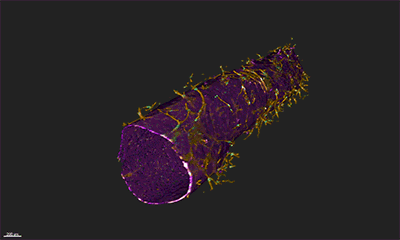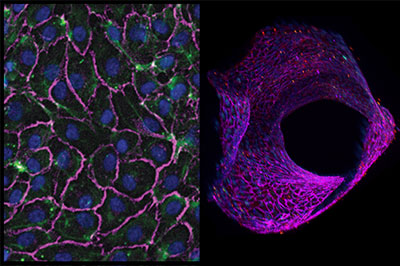A human blood-brain barrier-on-a-chip device developed at the Wyss Institute offers new ways of studying drug delivery and neurological disease in vitro
(BOSTON) — The blood-brain barrier at the interface between the brains blood vessels and nerve cells acts as a vital gatekeeper to the brain, allowing essential nutrients and fluids to pass into the central nervous system and the web of our brains neurons while keeping out harmful toxins and bacterial infection. Yet this barrier is so effective that it can also block the delivery of therapies for treating neurological diseases or brain injury.

A team at the Wyss Institute for Biologically Inspired Engineering, led by Wyss Institute Founding Director Donald Ingber, M.D., Ph.D., has advanced the Institutes Human Organs-on-Chips technology by developing a method for modeling the 3D structure of the human blood-brain barrier inside a microfluidic device, which will help scientists study human neurovascular function and inflammation in vitro. The research is described online in the March 1 issue of PLOS One.
“The blood-brain barrier is the first line of defense against chemicals and molecules that could induce brain injury, but it also blocks transport of potentially life-saving therapeutics to the central nervous system,” said Ingber, who is also the Judah Folkman Professor of Vascular Biology at Harvard Medical School and the Vascular Biology Program at Boston Childrens Hospital, as well as Professor of Bioengineering at the Harvard John A. Paulson School of Engineering and Applied Sciences.
“Its very difficult to get small molecule drugs and biologics into the brain due to the blood-brain barrier, and until now there hasn’t been a good in vitro model for studying the multi-cellular interactions that govern the barriers permeability in humans,” said Anna Herland, Ph.D., a postdoctoral fellow at the Wyss Institute and the first author on the new study.
To develop their 3D blood-brain barrier on-a-chip, the team used a microengineering technique to fabricate a hollow blood vessel lined by human endothelial cells surrounded by an extracellular matrix containing human pericytes and astrocytes that together form the blood-brain barrier within the microvessels of our own brains.
They did so by forming a microchannel inside a clear, polymer chip, filling the channel with collagen matrix containing human brain astrocyte cells, and then forming a long narrow lumen from one end to the other using a viscous fingering” method. The resulting lumen, representing the shape of a blood vessel, was then seeded with human brain pericyte cells and, finally, lined with living human endothelial cells that normally build the interior surfaces of our vessel walls.

Strikingly, over the course of the study, the human cells self-assembled to take on their normal positions as seen in vivo, with the pericytes in close apposition to the endothelial cells and the astrocytes cells extending through the collagen matrix to contact the endothelial cells. The cells, nourished by nutrients and a blood substitute flowing through the vessel-like microchannel, reconstituted a blood-brain barrier to small molecules similar to that seen in vivo.
Using this model, the Wyss team studied neuroinflammatory response in vitro by introducing a pro-inflammatory protein that is associated with several diseases of the central nervous system including Alzheimers, stroke, brain ischemia, multiple sclerosis, traumatic brain injury, and others. The experiment revealed that both pericyte and astrocyte cells can modulate the production of neuroprotective proteins, and that these cells can also act independently of one another in their response to inflammation signals.
The newfound ability to study these complex interactions in vitro is a significant advance when compared to traditional cell culture techniques, which do not mimic the physiologically relevant 3D orientation of different cell types and structures like the blood-brain barrier on-a-chip. This new device can be used to investigate the cause and effects of neuroinflammation, which play a central role in many neurological disorders, as well as to identify potential new approaches to develop drugs that selectively cross the human blood-brain barrier.